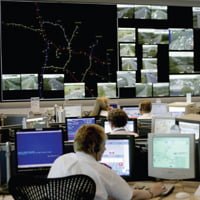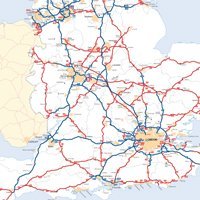
The strategic road network in England consists of motorways and major ‘A’ roads. It represents only 3% of all roads in England yet carries a third of all road traffic and two thirds of all heavy freight. The network is valued in excess of £84 billion and is vital for commerce and industry as well as day-to-day social activities. It connects towns and cities with ports and airports and is a key part of the transport infrastructure providing access to and from factories, shops, hospitals and services.
The Highways Agency was established in 1994. It is an executive agency of the Department for Transport and has responsibility for the operation of the strategic road network in England, within the context of the government’s aim of a sustainable transport system which will support economic growth. The Agency’s aim is: ‘safe roads, reliable journeys, informed travellers’. Its functions include tackling congestion, providing accurate information for drivers and improving safety.

The task of maintaining and operating the strategic road network is challenging. Since the first motorway was opened 50 years ago, the volume of traffic has increased massively. Vehicle use has risen by more than 80% since 1980 and today’s motorways carry more freight and passengers than was ever envisaged by planners.
The Highways Agency operates within a complex external environment. The government’s transport policy sets the overall agenda, but several other external factors impact on the Agency’s operations. PEST analysis is a useful tool to analyse these external forces and help inform future strategy and set priorities. This case study looks at the political, economic, social and technological factors that impact on the Highways Agency.
Political factors

The Highways Agency works in the interests of the public and not for private financial gain this is the same for all publicly-funded bodies. Its overall remit is set by Parliament with transport policy the responsibility of the Department for Transport. Political factors therefore play a key role in shaping its activities and priorities. Ministers are held to account in Parliament for the performance of the Department and its agencies, including the Highways Agency. The Agency has a duty to spend money wisely and cost-effectively and through Parliament, the Agency is ultimately accountable for its work to the public. Taxpayers’ money maintains the road network and taxpayers have a right to know how their money is spent.

The government sets the policy framework for the Highways Agency, therefore the Agency can be affected by political changes of direction. For instance, a change of government policy could switch some resources away from roads to rail transport.
The Highways Agency implements and informs government policy:
- One key priority is tackling traffic congestion. This affects the part of the Agency’s aim to deliver ‘reliable journeys’ and is an issue that affects both private road users and the economy as a whole. The Highways Agency is working to increase the capacity of the existing motorway network. It has tested a system called Active Traffic Management (ATM) on the M42 near Birmingham. ATM uses modern technology to allow motorists to drive on the hard shoulder during peak periods. This improves the flow of traffic and increases capacity when the road is at its busiest. The results have been good and drivers can predict with more confidence how long their journeys will take. For example, someone commuting to work every day can be sure they arrive on time. Businesses can improve the productivity of their commercial vehicle fleets. For example, a national distributor needs to be able to promise its customers such as major supermarkets, that products will arrive in time. A vehicle is not being ‘productive’ when it is sitting in a traffic jam. The fact this system has proved effective has influenced the government to use it on more motorways.
- Improving road safety is another priority. The Department for Transport has national targets to reduce the number of people injured or killed on roads.
Economic factors

A central aim of government policy is to encourage economic growth. In a growing economy, businesses produce and sell more goods and services. More jobs are created. The country becomes more prosperous. The Highways Agency supports economic growth, because an effective major road network directly helps business and industry. Factories need raw materials, retailers need to keep their shelves well stocked or risk losing business. Even internet businesses like Amazon need to distribute physical products to customers.
To develop the transport infrastructure, the government is committed to increasing capacity on some of the busiest roads. Increased capacity means more goods can be carried and people will experience less congestion. Although this is a short-term cost, it will reap long-term benefits. The Highways Agency is responsible for spending taxpayers’ money effectively and efficiently when improving the road network. However, England is a densely populated country and it is not possible to continue to build more and more new roads as this has financial, social and environmental impacts. For example, the paths of new roads might have to pass through countryside or close to housing. The Agency is continuing to deliver conventional road widening schemes. At the same time, as part of the new National Roads Programme it is also extending hard shoulder running to more key sections of motorway to help keep traffic moving. This will provide value for money to the taxpayer and improve the efficiency of the strategic road network.

In 2009 the UK economy went into recession. Rather than growing, the economy is contracting. People and businesses have cut back their spending. Many businesses have had to lay off workers. Although this may result in a short term fall in traffic levels, in the longer term traffic is still forecast to increase. This will put more pressure on the motorways so the case for increasing capacity still remains. The recession has other potential implications for the Highways Agency – by spending money on road improvements the Highways Agency can have an impact on the business cycle. To stimulate the economy out of recession, the government needs to encourage people and businesses to spend. It can try to do this by using a combination of monetary and fiscal measures. A monetary measure involves altering interest rates; fiscal measures concern levels of taxation and public spending. Many economists argue that governments should respond to recessions by increasing public spending. This is known as providing a fiscal stimulus – building Britain’s future.

The government is using the Highways Agency to boost public spending and stimulate the economy by bringing forward £400 million of spending on new and improved roads. Up to £100 million of this money is being put towards bringing forward the project to upgrade the A46 in Nottinghamshire to dual carriageway standard and provide bypasses for two villages. It will now be completed and open to traffic some five years earlier than originally planned. The Agency will also deliver extra works in order to get motorways ready for more hard shoulder running schemes and carry out numerous additional smaller road improvement schemes.
By bringing forward spending on roads, contractors will be hired to do the work. They will buy raw materials from other companies and this will help drive the business cycle. Economic activity is driven by sales as order books fill up, firms can grow. They then hire workers and workers spend wages. This has the eventual effect of increasing consumer demand.
Social factors

The Highways Agency’s work is directly affected by social factors. People’s lifestyles, attitudes and opinions have a direct bearing on traffic volumes. As society changes, the Agency aims to meet the needs of today’s road users by ‘putting our customers first in everything we do’. When motorways were first designed in the 1950s, traffic volume was much lower. Today most households own a motor vehicle and many people choose to drive rather than use public transport.

Why should it take a long time to travel by car because the roads are so busy? All of this leads to greater congestion and increases the need for more road capacity. In addition to expanding road capacity, the Highways Agency is taking socially acceptable measures to help road users make their journeys safely, reliably and without unforeseen delay.
It is:
- providing motorists with better traffic information both before and during their journeys to help them plan routes and make choices about when to travel
- aiming to influence people’s travel behaviour. It is working with large companies to encourage their staff to share car journeys to and from work
- patrolling the motorways 24 hours a day working hard to reduce the traffic hold-ups caused by incidents by clearing them as quickly as possible
- carrying out more roadworks at night when the traffic is quietest and delays can be limited.
It is also responding to another major public concern: the impact of human activity upon the planet. The Highways Agency adopts an environmentally friendly approach to traffic management. By keeping the traffic moving, emissions can be reduced as drivers do not have to constantly accelerate and brake. The Agency also protects wildlife that lives near the road network such as bats, otters and birds. It often uses recycled materials in its road building schemes and is one of the biggest tree planters in the country.
Technological factors

Using technology helps the Highways Agency respond to challenges posed by political, economic and social factors:
- The Agency uses an array of technology to monitor and control road traffic. CCTV is used to monitor conditions on the road network. Control room staff across the country use sensors in the road surface and over 1,200 CCTV cameras to quickly identify any emerging problems. Information is shared with broadcasters such as the BBC to keep drivers informed. In the event of an incident or breakdown, control room staff can quickly direct Traffic Officers to the scene.
- Over 1,200 kilometres of the motorway network are now covered by the Motorway Incident Detection and Automatic Signalling (MIDAS) system. This consists of sensors in the road surface, spaced at intervals of around 500 metres, which can detect slow moving or queuing traffic. The electronic signs on the road then automatically display reduced speed limits and messages such as ‘QUEUE AHEAD’. The idea is to warn drivers that there may be slow moving traffic ahead so that they can slow down and avoid having an accident. On some motorways this is taken a stage further by setting compulsory variable speed limits. This system helps to keep motorists driving at a speed which the system has calculated as the best speed to keep the traffic flowing. In the Active Traffic Management system it is also used to calculate the best time to open up the hard shoulder as an extra lane to help keep the traffic moving.
- At the end of March 2009, over 85 busy junctions also now have ramp metering, which uses traffic lights on entry slip roads to control the flow of vehicles on to the motorway. It lets vehicles onto the motorway a few at a time to prevent traffic building up. The Agency is investigating other locations where ramp metering can help to reduce congestion.
- By giving road users the latest information on traffic conditions they can choose to take another route, allow extra time and/or delay their journey. The Agency helps by giving motorists the most up-to-date information where and when they want it: via its own DAB digital radio station, Traffic Radio, which is also available online, information points at some motorway service stations and via its Traffic England website or the ‘mobile-friendly’ website.
- On the road itself, the Variable Message Signs (VMS) system displays live messages to road users telling them how long it will take them to drive to certain key motorway junctions in the current traffic conditions.
Conclusion

A PEST analysis is a useful technique for reviewing the external forces that impact on an organisation. The technique offers a structured basis for reviewing the organisation’s strategic direction and for considering future priorities.
In the case of the Highways Agency, as a government agency, political factors play a key role in shaping its activities and priorities. It acts in the public interest, has priorities shaped by government targets and is accountable to Parliament. Economic factors influence its spending decisions, social factors shape the demand for the Agency’s services and technological developments can offer innovative solutions to some of the challenges in managing a modern road network. By understanding these factors in the external environment, the Highways Agency can shape its activities appropriately. This is reflected in the current programme of ‘managed motorways’ which brings together many of the innovations to maximise use of the current infrastructure.
